Table of contents
- Motorcycle tour in Peru – from south to north Great travel destination for bikers
- The gateway to the deepest canyon in the world
- Tired truck drivers and asthmatic Toyotas
- The traffic is the sheer horror
- Apocalyptic wall made of rain clouds
- More than 30 km / h are life-threatening …
- Death Road only ends after four hours
- Information about the motorcycle tour through Peru
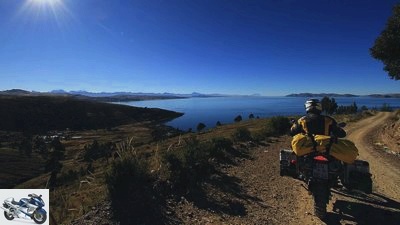
Markus Biebricher
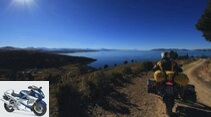

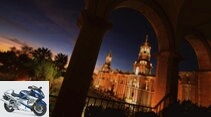
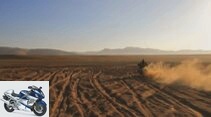
15th pictures
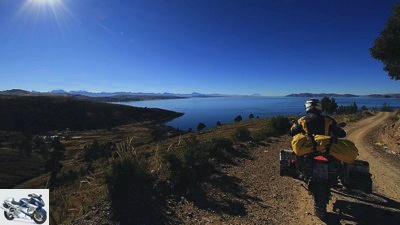
Markus Biebricher
1/15
In Peru, one of the most diverse countries on earth, you can commute between the extremes. More variety, more curves, more mountain passes, more coastal roads, more impressions of nature, more social contacts are hardly possible in six weeks of life. A great travel destination.
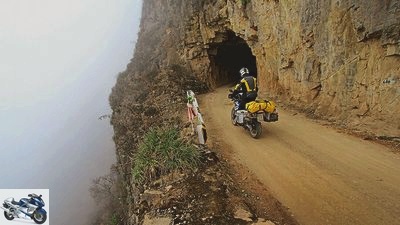
Markus Biebricher
2/15
The slope from Cascas to Contumazá is especially adventurous in fog.
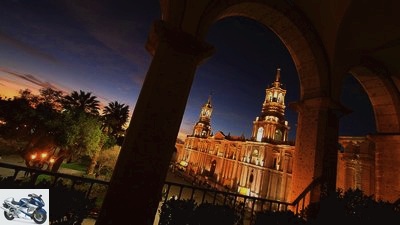
Markus Biebricher
3/15
Plaza de Armas in Arequipa including the cathedral.
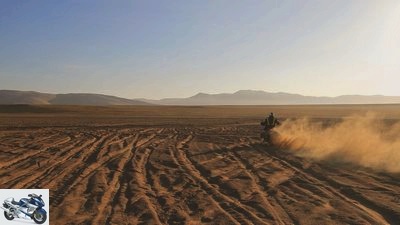
Markus Biebricher
4/15
Enduro freedom on the Paracas Peninsula.
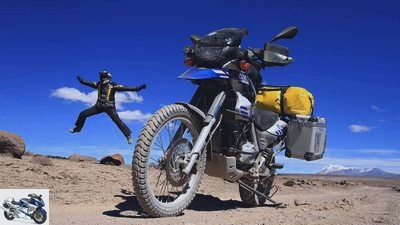
Markus Biebricher
5/15
Jump for joy near the Passo Patapampa at an altitude of 4900 meters.
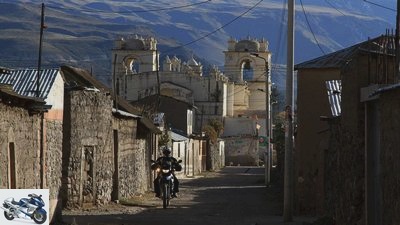
Markus Biebricher
6/15
An idyllic village called Yanque.
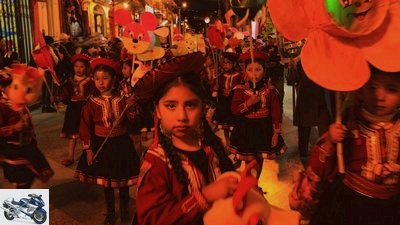
Markus Biebricher
7/15
Hundreds of children at the Fiesta de la Luz, the festival of lights, in Puno.

Markus Biebricher
8/15
A young alpaca female on the edge of the path.
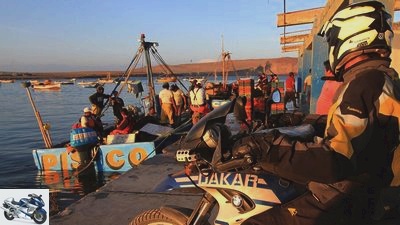
Markus Biebricher
9/15
The port of Lagunillas near Paracas.

Markus Biebricher
10/15
The Panamericana is a grandiose coastal road between Cerro de Arena and Atico.
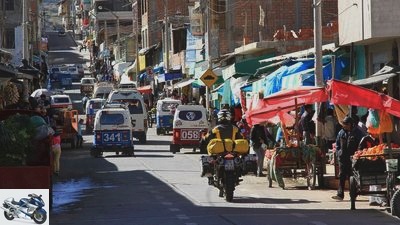
Markus Biebricher
11/15
Street scene in Puquio with the three-wheeled mototaxis so typical of Peru.
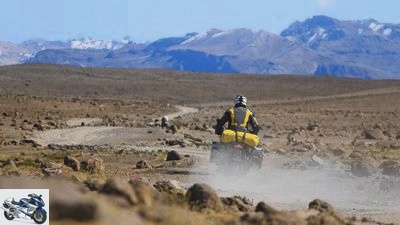
Markus Biebricher
12/15
Off-road route to Chivay.
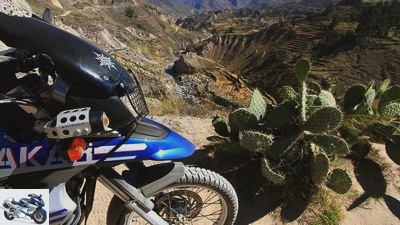
Markus Biebricher
13/15
On the way to the Colca Valley: valley cut.
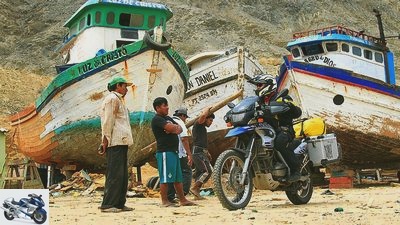
Markus Biebricher
14/15
Inquisitive fishermen in Yacila dry dock.
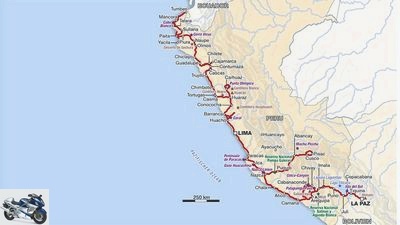
Map: Claudia Werel
15/15
Driving through Peru by motorcycle is a dream and will stay in your memory forever. Duration of the trip: 42 days; Distance covered: 6,200 kilometers.
to travel
Motorcycle tour Peru – from south to north
Motorcycle tour in Peru – from south to north
Great travel destination for bikers
In Peru, one of the most diverse countries on earth, you can commute between the extremes. More variety, more curves, more mountain passes, more coastal roads, more impressions of nature, more social contacts are hardly possible in six weeks of life. A great travel destination.
Markus Biebricher
07.12.2017
Icy wind rushes into the helmet, then the sun rises and Lake Titicaca comes into view. What a blue! We lay down in countless curves along the huge Andean Sea. In the background snow-covered mountain ranges of the Cordillera, a never-ending, goose bumps driving experience in front of a large backdrop.
Buy complete article

Motorcycle tour in Peru – from south to north
Great travel destination for bikers
12 pages) as PDF
€ 2.00
Buy now
Folks, if you want to enter Peru from the south, visit Copacabana! Just a few kilometers from the Peruvian border there is a cathedral like something out of a fairy tale and (in addition to many unspectacular accommodations) two hotels in the best panoramic location with buildings like in a fantasy film. They belong to Martin Stratker, a boy from the Ruhr area who settled here a good 25 years ago. Martin keeps cuddly alpacas as lawnmowers and wool donors, runs a restaurant that is probably unparalleled in all of Bolivia, and shows us secret slopes and Indian villages along the shores of the unearthly blue lake on his Chinese Enduro.
The gateway to the deepest canyon in the world
The Lago Titicaca also accompanies us in Peru. However, its banks no longer match the dramatic beauty of the Bolivian side. It only gets really wonderful again on the Patampa Pass: You will marvel at the endless expanses and smoking volcanoes. A sky almost as blue as the Titicaca. To do this, you breathe thin, but extremely clear air. And be amazed that, despite 84 octane fuel, despite overloading, your bike still runs like clockwork at almost 5,000 meters.
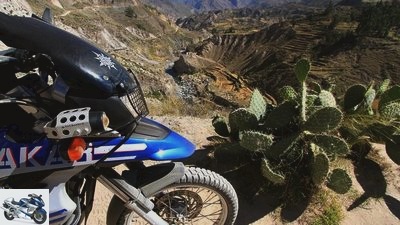
Markus Biebricher
On the way to the Colca Valley: valley cut.
“If you want to see the Andean condors in the Colca Gorge, you have to be there at sunrise,” says our landlady in Chivay, the gateway to the deepest gorge in the world. Up early again? We have to thaw in the sun first, please. Then it goes through a valley that looks like the first day of creation. The gravel road, which is initially easy to drive, leads through Yanque and Cabanaconde, pretty cute villages. Behind it, the path eats its way through tunnels roughly cut into the rock. At some point the edge of the Colca Gorge is reached. Not a tourist far and wide, just a lonely dog from nowhere and a look into the depths. If you could fly now.
Then they rise. The updraft carries them up past us like black planes. What mighty, lofty birds, these condors. A gift to experience the animals even outside of the “official visiting hours” without an army of Chinese people pulling their cameras. There will be later in Arequipa, where we enjoy a special city culture in the shadow of the mighty Misti volcano. The loyal motorcycle gets 91 octane fuel.
Then the wind blows us from the mountains to the coast. Is it the light or the mood? The much scolded Panamericana surprises as far as Nasca with sections that throw themselves towards the front wheel in wild beauty. Each work cycle of our single cylinder stamps these impressions indelibly in the amygdala and hippocampus. And these are after all those brain regions that are important for the emotional evaluation of stimuli and for memory formation.
Tired truck drivers and asthmatic Toyotas
The “Lines of Nasca”, millennia-old scratching images in the sand, ensure that the synapses continue to glow. Or the route to Cuzco, blessed with what feels like a million curves. In no time at all, our brave single-cylinder pushes us back to over 4,000 meters, glides through dusty fields where farmers with weather-beaten Indian faces wring a small harvest from the barren soil. In the expanses between the mountains, vicuñas graze, whose fur provides the most precious wool of all. The shy animals are the real gold of the Andes.
In 1532 the Spanish conqueror Francisco Pizarro didn’t care. He hungered for precious metal and brought down the overpowering, tightly organized Inca empire with its 10 million inhabitants with a total of 160 warriors and nasty tricks. The former center of Inca culture is Cuzco. It is also called “El Dorado”, the golden city, because most of the houses here used to be clad in gold. But gold was only an ornament. Before the Spaniards stole it, all the gold belonged exclusively to the gods.
Small slopes and roads are ours alone. Larger streets are frequented by tired truck drivers and asthmatic Toyotas waiting for total failure. Behind every person we ask for directions there is a fate. We would love to know more about the life of these inhabitants, which seems simple but is actually complex. Which is also due to the fact that the old Inca deities have to be humorously combined with the long-established Christianity every day.
The traffic is the sheer horror
Shortly before Lima we visit the Paracas peninsula. A nature reserve full of endless wild sandy deserts, bizarre cliffs and rare biodiversity of sea birds and marine mammals. Peru’s capital is the stark contrast to this wonderful nature. After all, we can really freshen up here and our Enduro can enjoy 98 octane.
Later, the motorcycle eels at 0 to 10 km / h through apocalyptic car avalanches. I circle the aluminum suitcases so close to the sheet metal that no sheet can fit between them. Drivers who are nervously stressed fight for every gap in this traffic hell, even if they don’t fit. Sodom and Gomorrah. Those who do not fight have lost.
Lima’s old town may be a UNESCO World Heritage Site, but the traffic is the sheer horror. Within a very short time, the German BMW mutated into a traffic light miracle. Thank you, Lima, for the intensive course in vehicle control and traffic psychology. After five hours in first and second gear, I’m happy to be able to shift up a gear.
The development is subsiding, it is getting dark. On the right, desert sand blows onto the road, on the left the terrain slopes steeply towards the sea. Then darkness eats up the landscape, you slide through the blackness and feel like a space surfer. Huacho is still 120 kilometers away, time and space are blurred. After what feels like an eternity through the coastal desert, the place comes into view, but our pre-booked accommodation is far outside in the middle of nowhere. The cone of light cuts a path through the fields. Then the slope ends at a wall. Behind it is Deisy Vega Rojas and her little Garden of Eden.
Apocalyptic wall made of rain clouds
The spirited, cultured woman spoils us with life wisdom, travel tips, energetically charged water, and home-grown fruit and vegetables. Her “Villa Kitzia” is named after her daughter, who gives Spanish lessons to guests. Kitzia is only seven, but with this authority she could also earn respect from a Berlin high school class.
You have to break away by force, otherwise you will never end up in the long-awaited Cordillera Huayhuash. Deisy puts granadillos and tuna in our luggage, you never know. Our single-cylinder pushes east on a narrow, heavily patched road. Then the junction comes to the slope, which spirals up steeply. We’re making much slower progress than we thought. Don’t want to admit it, but the imposing mountains are hidden behind an apocalyptic wall of rain clouds.
We don’t stand a chance at this rate. We shoot and dare to make a new attempt from Barranca. Ruta Número 16 leads towards Huaraz, the main attraction in the Cordillera Blanca. It would be good if we could get there today. The cozy coastal warmth lasts up to around 3,000 meters, then the icy cold eats its way into the station wagons. In addition, fog and rain are now hitting relentlessly. In the villages, dogs chase out of the fog like ghosts, the enduro is their enemy. You can’t see anything anymore, you poke at a snail’s pace through grandiose landscapes that you can’t even guess.
More than 30 km / h are life-threatening …
Dripping wet and frozen, we stop in the middle of nowhere. The mood of the end of time spreads, then suddenly two V-Strom pilots from Cali, Colombia, come thundering. The three of us feel our way through the thick soup. It goes up to well over 4,000 meters, the road is as smooth as glass. Black night falls like volcanic ash. More than 30 km / h is life-threatening, but our BMW-Suzuki community of fate saves a bit of morale right up to the seemingly unattainable goal.
Shivering, we rent the first hostal we come across. Now a hot shower, but the trickle remains ice cold. Better not talk about the night Better for the day: First we cruise north along the Rio Santa, then the Enduro pushes us steeply from Carhuaz into the mountains towards San Luis. The route is breathtaking, the hairpin bends are endless, every now and then one of the 6,000-meter peaks pulls the cloud cover off your face. Boulders lie on the badly patched road. The Punta Olímpica is at 4,890 meters. Laguna Belaúnde shimmers blue behind it, her colleague Laguna Yanarraju below green. Now the BMW gets stuck in the snow. The world sinks into white, there are no more noises and distances. Continue? Not possible! So wait until it clears up again.
It wasn’t until late in the afternoon that the motorcycle screwed its way down the hairpin bends until the first villages appeared. And the first trees. Almost everything is eucalyptus, which vigorously exudes its typical fragrance. We are invited to a village festival. “What are we celebrating? The end of the school year ”is the answer to our question. The women wear brightly colored skirts and a towering, ornate hat.
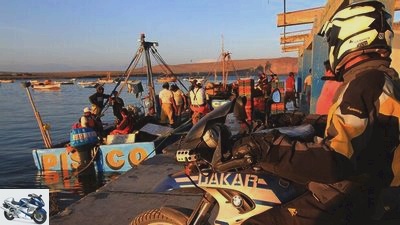
Markus Biebricher
The port of Lagunillas near Paracas.
Adobe brick houses line unpaved village streets. They are simple, often unplastered, the kitchen is on the doorstep. Children are washed in the sink, the elderly sit wrapped in their ponchos on the clay floor and watch. The donkey is the means of transport for agricultural goods, we no longer meet llamas and vicuñas in northern Peru.
And the Cordillera Blanca? Doesn’t seem to want the Germans. The following days will also see heavy rain and snowfall, which is not without danger in the mountains. What to do? Wait? Or over the Cordillera Negra the 200 kilometers to the sun-drenched coast? The decision is made in favor of the warmth, we cross the Negra on spectacular roads. Whenever you think you are about to be down, a new, even deeper canyon with hairpin bends opens up below you. Traffic? Buses and trucks have a hard time here. At 2,500 meters above sea level it is getting warmer, from Casma the desert landscape rolls out again in front of the handlebars.
Folks, if someone should tell you that the coast up here in the north is boring, don’t believe them! The sunset in the fishing village of Tortuga is unique, the sand on Atahualpa beach near Chimbote is at its best, the bathing experience is intense because there are great surf waves, but also insidious undercurrents.
Death Road only ends after four hours
The people are extremely helpful and communicative, so traveling is more relaxed than in the more touristy south of Peru. Here in the north the “W-questions” (where from, where to, why, how expensive, how fast?) Are asked with never-ending vigor.
The question we ask ourselves also begins with a “W”: Do we want to try one last time to challenge the mountains? Yes! So let’s go east. On a secluded lane towards Cajamarca. Shortly after Cascas begins a piste that has it all: a bend every ten meters, the ground is difficult even when dry. It shouldn’t rain here. The path winds its way mercilessly towards the sky, palm trees and cacti are left behind, and sometimes you drive straight through a small farm. Again we are approaching the 4,000 mark. And again it gets dark, although it is only noon. Oh Dios, don’t let it rain now. The Lord shows mercy, but sends such thick fog onto the slopes that we are even in first gear at low speed. People or animals only peel themselves out of the soup at the last second, and sometimes the rock next to the slope drops vertically.
A death road that only ends after four hours in the beautiful Andean town of Contumazá at around 2,800 meters. From here a narrow strip of asphalt leads towards the access road 08 to Cajamarca. The number and density of the curves mark a new record, at least when we are talking about fairly paved roads. Around 80 kilometers before Cajamarca, then again fog, rain and dangerously decreasing grip. Okay, the mountains don’t want us this time either. If you have fought for Cajamarca, however, a pulsating mini-metropolis with a great old town, impressive churches and cultural diversity awaits.
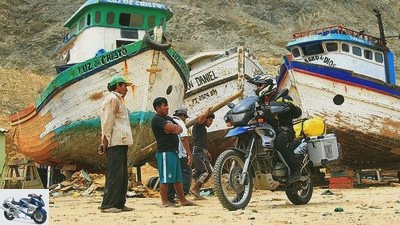
Markus Biebricher
Inquisitive fishermen in Yacila dry dock.
And approachable people are always waiting: In San Juan the old lady who doesn’t know which road leads to the coast because she has never left the place in 80 years. The policemen in Chilete who want to seduce us to have a beer for lunch. “We’re not on duty, so drink, amigo.”
Those who want to travel from Chiclayo to Piura can do kilometers on the new Panamericana close to the coast. Alternatively, there is the old, longer connection through the Sechura desert. Just the thing for tourists who are looking for wild west romance or looking for handmade ceramics in remote villages. In fact, there are masters who can be seen making pottery.
Much more is possible here in northern Peru. In the fishing village of Yacila we get a crash course in classic wooden boat building, raft fishing and dismantling sea animals. In Puerto Blanco we help fishermen push their cutter into the water. A miserable drudgery on tree trunks, the motorcyclist from Alemaña has too few muscles, say the pescadores. Further out, freshly caught fish is brought to the pier from the boat. A spectacle that is shaped by sea lions, pelicans, frigate birds and 14 large sea turtles. Everyone is hungry and hunted down their share of the prey in spectacular stunts.
Later, the trip to Talara is also spectacular. Both the maps and the navigation system simulate a runway near the sea, only a small river called Rio Chira has to be crossed. “No problem,” says the employee of an oil company, “you can drive through with this motorcycle.” “No problem”, says a cyclist, “there is a ferry over there.”
Vamos, but the ford is far too deep, the “ferry” is a ramshackle rowboat. “No problem,” says the captain. The BMW slides down the steep bank prematurely, but how is it ever going to get into the much too small sloop? Finally, villagers are pushing us back onto the slopes. If they hadn’t helped, the BMW would have rotted in the sand – and we wouldn’t have felt the wind on our faces anytime soon.
Information about the motorcycle tour through Peru
General: Peru is located in western South America and borders Ecuador and Colombia in the north, Brazil in the east, Bolivia in the southeast, Chile in the south and the Pacific in the west. Its largest rivers are the Amazon and its headwaters Río Apurímac, Río Urubamba, Río Ucayali and Río Marañón. Lake Titicaca and Lake Junín are the largest lakes between the Andean chains.
The highest mountains: Nevado Huascarán (6768 m), Yerupaja (6634 m), Coropuna (6425 m), Ampato (6310 m), Chachani (6075 m), Alpamayo (5947 m) and the Misti volcano (5822 m). Peru consists of three landscape zones, including their climatic peculiarities: The Costa (coast) makes up twelve percent of the national area, the Sierra (Andes, highlands) makes up 28 percent. Rainforest and cloud forest (Selva) cover a lush 60 percent of the ground. The Costa is under the influence of the Humboldt Current and is largely a coastal desert. In the southern area of the Costa to the capital Lima, rainfall is rare throughout the year. To the north of it, soil quality and rainfall increase. Temperatures vary between 12 ° C in winter and 35 ° C in summer. The flora of Peru is also diverse. Only a few grasses grow in the dry and sandy coastal plains, whereas in the rainforest there is lush vegetation: rubber, mahogany trees and vanilla plants are native here, while cacti and mesquites thrive in the high mountains.
The coastal plain is populated by seagulls, terns, lizards, scorpions, seals and penguins. In the Peruvian coastal waters, there are sardines, lobsters, mackerels and around 30 species of whales and dolphins. Animals of the more fertile regions in the east are armadillos, alligators, jaguars, pumas, parrots and flamingos. Bumpless camels such as llamas, alpacas and vicuñas live in the mountainous region. By the way: With 1,800 species, Peru is the country with the greatest diversity of birds in the world.
In addition, the country has a large proportion of indigenous people. 37 percent of the population are mestizo, 47 percent of Indian descent. The latter mostly belong to the peoples who still speak the ancient languages Quechua and Aymará. 15 percent of Peruvians are of European descent, the rest are Afro-Peruvians and Asians. In the rainforest on the border with Ecuador there are around 15 previously uncontacted Indian groups (“No Contactos”) who have an internationally recognized legal right to isolation.
Story: A central element in the history of Peru is the Inca Empire. Powerful, cruel, perfectly organized and a cult of the dead that made the expansion of the empire necessary. It originated around 1200 and spanned large parts of today’s states of Colombia, Ecuador, Peru, Bolivia, Argentina and Chile by 1532. The city of Cuzco, located on the plateaus of Peru, was the cultural center and capital. Spanish conquerors around Francisco Pizarro brought the world empire down. To this day, relics of the Inca culture determine the image of Peru, Christianity mixes well with Inca elements.
Sightseeing features: The whole diversity of the country is expressed in countless sights that would take months to examine. Therefore only a short and arbitrary selection: Lima, Cuzco, Machu Picchu, Nasca, Arequipa, Colca Canyon, Yanque, Chachapoyas (Kuelap), Paracas Peninsula, Cordillera Blanca (Huaraz), Ollantaytambo, Trujillo, Moyobamba, Tambopata, Cajamarca, Huacachina oasis. The latter, Lake Titicaca and Machu Picchu are unfortunately nowadays tourist check-in machines. Therefore, it is better to visit the Titicaca on the Bolivian side. The north of Peru is far less touristy than the south.
Travel time In European winter, the weather in the Peruvian Andes is clear and cool. On the coast it is often foggy and cloudy, but warmer. In the European summer it is often the other way round.
Security: The security situation is harmless with the exception of a few areas, but at night you shouldn’t necessarily roam through dark city districts alone as a “rich gringo”. Peruvians are very helpful, in the northern part this virtue intensifies even more.
Stay: Wild camping is possible, but not widespread, campsites are rare, but hostales can be found in almost all places at very affordable rates up to higher price regions. Special recommendation: Hotel “Villa Kitzia” in Huacho run by the charming host Deisy Vega Rojas. Address: Psj.Escolar S / N Pueblo Viejo, Santa Maria, Huacho, Peru. Telephone: 00 51/9 80 82 87 84, information on the net: https://hotelvillakitzia.com
Motorcycles / Organized Travel: The top address for transporting motorcycles to South America: InTime Forwarding & Courier, Olaf Kleinknecht, www.intime-ham.com, info@intime-ham.com, phone 0 40/59 35 92 40.
Good address for motorcycle rentals and exciting, safely organized tours to many of the country’s highlights, but also across borders: Motoviajeros Peru S.A.C, Ivan and Ines Guerrero, Av. Los Faisones 196, La Campina – Chorillos, Lima, 09
Peru, phone 0051/989/032678, ventas@motoviajerosperu.com, www. motoviajerosperu.com or www.gs-sportreisen.de; www.delbondio.de; www.gat-motorradreisen.de; www.overcross.com; www.motoaventura.de; www.edelweissbike.com; www.perumoto.com
Literature:
Karin Muller: Along the Inca Road, National Geographic.
Ulrike Fokken: Instructions for use for Peru.
Ines de Castro: Inca – Kings of the Andes.
Martin Morales: Ceviche – Peruvian cuisine.
Stefan Loose: Travel Guide to Peru.
Cards:
Friday & Berndt: Peru, 1: 1,000,000.
Michelin: Peru, 1: 1,500,000.
Travel Know-How Mapping Project: 1: 1,500,000, www.maps4u.com
Related articles
-
Motorcycle tour – the north of Chile
Markus Biebricher 14th pictures Markus Biebricher 1/14 Communicative: break at the trucker bar in the middle of nowhere Markus Biebricher 2/14 Evening…
-
Motorcycle tour in Portugal: relaxed through the north
Markus Jahn 28 pictures Markus Jahn 1/28 Fly to Porto with small luggage – and from there feel like a factory driver. Freeride Spirit founder João Roxo…
-
Motorcycle tour through Algeria
to travel Motorcycle tour through Algeria Motorcycle tour through Algeria The dunes of the Sahara Algeria. The grave road, the sand dunes from Erg…
-
MOTORCYCLE tour tip – South Dolomites
Tour tips Exclusive motorcycle tours for children to follow Presented by Jorg Kunstle to travel MOTORCYCLE tour tip – South Dolomites MOTORCYCLE tour tip…
-
MOTORCYCLE tour tip – Black Forest south circuit
Tour tips Exclusive motorcycle tours for children to follow Presented by Dirk Schafer to travel MOTORCYCLE tour tip – Black Forest south circuit…
-
Motorcycle tour Cuba: more than just a relaxing vacation
Thorsten Dentges 35 pictures Thorsten Dentges 1/35 Blue sky, turquoise sea, white sand – this is how we know Cuba from the catalog and this is how it can…
-
MOTORCYCLE tour tip – The Alsace gourmet tour
Tour tips Exclusive motorcycle tours for children to follow Presented by Jorg Kunstle to travel MOTORCYCLE tour tip – The Alsace gourmet tour MOTORCYCLE…
-
Motorcycle tour tip North Eifel – Rursee tour and Nonnenbach tour
Tour tips Exclusive motorcycle tours for children to follow Presented by Claudia Werel to travel Motorcycle tour tip North Eifel – Rursee tour and…
-
On the way: from north to south through Africa
Obert 22nd pictures Obert 1/22 Sudan: invitation to dinner with new friends in the Nubian desert. Obert 2/22 Local motorcycle ferry across the Rovuma…
-
Motorcycle tours through Germany: North Rhine-Westphalia
shepherd 13th pictures shepherd 1/13 Motorbike tour through North Rhine-Westphalia. Sauerland and Bergisches Land are biker hits. shepherd 2/13 As a good…